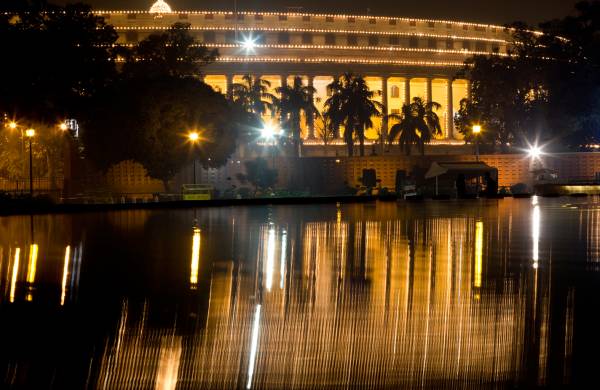India’s Tryst with Revolutionary Tax Reform
On July 1, India’s famously labyrinthine tax code was scrapped for a much simpler one that may unleash enormous potential.

India’s tax overhaul will dismantle a mishmash of 17 different tax systems and replace them with a single tax. | iStock: triloks
Among the seminal moments in India’s economic history, two stand out so far. July 24, 1991, is one: the day that Prime Minister Rao’s government announced a comprehensive set of economic reforms focused on deregulating the nearly bankrupt economy.
November 8, 2016, is the other: the day that Prime Minister Modi eliminated 86 percent of the country’s currency to crack down on tax evasion and thus spark faster growth. July 1, 2017, may need to be added to this list. It marked the day when India’s famously labyrinthine tax code was scrapped for a much simpler one that may unleash enormous potential.
Before plunging into the tax details, it’s worth noting how the indefatigable Mr. Modi spent last week. Not content to stay home on the eve of such a landmark event, he traveled to Washington, DC (prompting the Indian media to speculate about his sleep habits), where he met with President Trump and gave him something approximating a bear hug. That meeting was an opportunity for both countries to showcase the importance they attach to the bilateral relationship, which Mr. Modi touted in a Wall Street Journal op-ed.
But perhaps more important to India’s economic prospects was the slate of Mr. Modi’s meetings the day before. The CEOs of numerous blue-chip companies (including Adobe, Amazon, Apple, Cisco, Deloitte, EY, Google, JPMorgan Chase, Mastercard, Marriott, and Walmart) trekked to Washington to meet with Mr. Modi. The CEOs, despite the diversity of their lines of business, were united in recognizing the value of the Indian market. To wit: Amazon has invested $5 billion in the country, while Apple started manufacturing in Bangalore just six weeks ago, and just two weeks ago Lockheed Martin reached an agreement with India’s Tata Advanced Systems to produce F-16 fighter planes in India for the country’s air force.
Those examples illustrate the mutually beneficial, expanding web of business ties between the two countries. Over the past two decades, annual trade between the U.S. and India has grown from less than $20 billion to $115 billion. U.S. exports to India support 197,000 American jobs, according to the U.S. Commerce Department. Bilateral foreign direct investment has similarly surged. Investment in the U.S. by Indian companies exceeds $11 billion, creating and sustaining more than 52,000 jobs, according to the U.S. Bureau of Economic Analysis. And U.S. FDI in India has more than tripled from $800 million in 2014 to $2.4 billion today (according to the U.S. Vice President, Mike Pence)—investment that benefits not only India but the U.S. economy as well (as we wrote about recently).
Saturday’s tax overhaul in India, which ushered in what is known as the Goods and Services Tax, should eventually expand these sorts of business ties. It is widely recognized as the country’s most comprehensive tax measure in the post-independence era. To underscore the enormity of the moment, Mr. Modi delivered a speech about the reform at the midnight hour it was to take effect—hailing it as a “landmark achievement which is bound to take the nation towards exponential growth.” The timing was not a coincidence, as it was meant to evoke Prime Minister Nehru’s fabled midnight speech as the country gained independence.
The GST’s practical effect will be to dismantle a mishmash of 17 different tax systems, which fostered throughout the economy corruption and inefficiencies, and replace them with a single tax. In some respects, creating the GST will unify India’s 29 states and seven union territories as if they had signed with each other a free-trade agreement. Of course, it’s not quite that simple (nothing with taxation ever is). There will still be four different tax rates—5, 12, 18, and 28 percent. There are the inevitable distinctions that seem nonsensical, such as one rate for hotels that provide air conditioning and a different (lower) rate for hotels that don’t. A 213-page guide explains everything; a useful explanatory video can be found here.
The GST nonetheless holds great potential. Whether that potential is met will largely depend on whether the government gets implementation and enforcement right. A poorly functioning government has held back India’s growth for decades, since the state too often “does what it does not need to do and fails to do what it does need to do,” as Financial Times columnist Martin Wolf wrote recently. The country’s finance minister has predicted that full implementation will increase the country’s economic growth rate by two percentage points per year. If the GST works as promised, its gains will accrue not just to India—which, at 1.3 billion citizens and counting, is set to become the world’s largest country in a few years—but to the world as well.
On the eve of India’s independence, Prime Minister Nehru famously spoke of the country’s “tryst with destiny.” Mr. Modi’s revolutionary tryst with tax reform should help boost its economic potential to build an even stronger tomorrow for the country. Good on him.